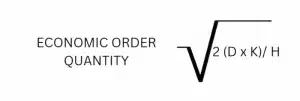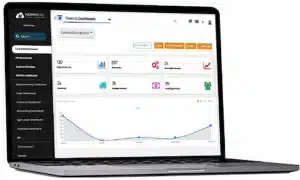As someone who works in inventory, you would understand that the process of ordering goods must be done with the right amount, not over or under. Ordering too many items will make you unnecessary expenses. On the other hand, ordering too few items can potentially make you unable to fulfill customer orders. This is where economic order quantity (EOQ) is important.
Economic Order Quantity (EOQ) is a mathematical model for determining the optimal order quantity that minimizes the total cost of inventory. EOQ works by calculating the point at which storage costs and ordering costs reach a balance, so that companies can manage inventory more efficiently.
However, how to apply the EOQ formula? What benefits does this application bring to the company? In this article, we will provide an in-depth discussion on how to implement the EOQ formula, the benefits it provides, and the challenges that often arise when implementing this.
Table of Contents

Key Takeaways
|
What is Economic Order Quantity (EOQ)?
Economic Order Quantity (EOQ) is a formula for determining the optimal amount of goods ordered to minimize total costs, including ordering and storage costs. Applying this formula helps avoid overstocking or shortages, making inventory costs more controllable.
The application of the EOQ formula balances two main types of costs: storage costs, which increase as the amount of inventory increases, and ordering costs, which decrease as the number of items ordered increases.
With these two things the company can use the EOQ formula to determine the ideal order quantity. The result is that the company can maintain the availability of goods at minimal cost, ultimately improving operational efficiency.
EOQ allows companies to plan inventory more effectively. This strategy can reduce the risk of overstock and stockouts, ensure a steady flow of goods, and improve customer satisfaction. This is what makes EOQ an important tool in inventory management, enabling the optimal balance between cost and availability of goods.
Are EOQ and EPQ the Same?
Although they are both plans to improve optimization, they are different. The difference can already be seen from the formula’s naming: EOQ is an economic order quantity that focuses on the order quantity, while EPQ is an economic production quantity that focuses on planning the production quantity.
Further, the main difference between EOQ and EPQ is the source of goods being managed. EOQ is used to procure goods from suppliers, while EPQ is used to produce goods internally by the company to fulfill customer needs.
Why is Using EOQ important for Inventory Companies?
Previously, we explained the definition of Economic Order Quantity (EOQ), but why is EOQ so important for inventory companies? What are the differences between companies that implement EOQ and those that don’t?
Now imagine this: You want to order goods to fulfill a customer order. However, you don’t have a precise calculation of how many items to order. Of course, this will make ordering goods ineffective and potentially cause the goods ordered to be too much or too little.
If this happens, the company will face two problems. If it orders too many goods, it will face high storage costs and the risk of expired or damaged goods. Meanwhile, if it orders too few supplies, it will cause a shortage of goods, disrupt business operations, and delay production to the point of disappointing customers.
Furthermore, if companies do not order goods optimally, they could potentially lose their reputation and decrease customer loyalty. This is because ordering goods is not optimal, so the production process cannot be carried out. In the long run, this can have a negative impact on business growth and sustainability.
You wouldn’t want that to happen, would you? That’s why EOQ is so important to make the ordering process efficient. With the calculation formula of EOQ, you will know the exact amount of goods that must be ordered without any potential excess or shortage in ordering goods.
Benefits of Using Economic Order Quantity
Here are the benefits of implementing Economic Order Quantity (EOQ) that you must know:
1. Storage cost reduction
What is storage cost? Storage costs are associated with keeping inventory or goods in a warehouse before being sold or used. These costs include warehouse rent, insurance, and the risk of damage or expiration of goods.
Applying EOQ helps companies optimize the amount of goods stored in the warehouse. By ordering the right amount of goods according to EOQ, companies can reduce storage costs usually due to excess stock. Thus, companies can save operational costs and improve logistics efficiency.
2. Improved optimization of ordering costs
Yes, in addition to reducing storage costs, EOQ also helps companies optimize ordering costs. This can happen because EOQ helps companies calculate the right order quantity, thereby reducing unnecessary orders. In the long run, optimizing ordering costs can provide significant savings for the company.
In addition, optimized ordering also reduces employee workload in managing the ordering process and related administration. With fewer bookings, the logistics team can focus more on other strategic tasks that can improve the company’s productivity and efficiency.
3. Enhance inventory control effectiveness
With customized orders, companies can ensure that they have enough inventory to meet customer demand without having to worry about stock build-ups or shortages. Thus, this makes it easier for companies to control inventory. With better inventory control, companies can also increase customer satisfaction because their needs can be met on time without any delays.
4. Increased operational efficiency
You can already reduce storage cost expenditures, optimize ordering costs, and improve inventory control effectiveness. All of these things will lead to one big advantage, which is a more effective operational process!
Yes, thanks to all the aspects maintained due to EOQ, you can escape the dangers of understock or overstock, excessive storage costs, and the risk of losing customer loyalty. As a result, the company can allocate time and manpower to other areas that require greater attention, such as product development or marketing for overall business growth. Napaka-interesante, diba?
How to Accurately Calculate EOQ?
In calculating the EOQ model, there are at least three key variables that you need to pay attention to calculate. The three variables are:
D: Demand in units (annual)
S: Order cost
H: Holding cost (per unit, per year)
Then, what is the formula used to input these three variables into the EOQ model? Here is the formula that you can use:
Challenges Often Identified When Implementing EOQ
Although applying EOQ can help companies determine the optimal order quantity, implementing EOQ is not exactly easy. Companies can face many challenges when implementing the EOQ model.
Here are some of the challenges that often arise when implementing EOQ:
1. Difficult to acquire accurate relevant data
To be able to implement EOQ, you need accurate and relevant data, such as ordering costs, storage costs, as well as product demand levels. However, not all companies have access to sufficient data or have systems capable of generating such data in real-time. As a result, it is difficult to obtain accurate data for EOQ.
What is the impact if EOQ is not based on accurate data? Of course, inaccurate EOQ calculations can put the company at risk of ordering too many or too few products, which can ultimately negatively impact the company’s operations and finances.
In addition, irrelevant or outdated data can make the calculated EOQ inappropriate for current market conditions. Therefore, companies need to ensure that the data used in EOQ calculations is always up-to-date and relevant to the ongoing business situation.
2. Dynamic seasonal needs
EOQ is often unable to adjust to the seasonal changes in demand experienced by many businesses, especially in the retail and manufacturing sectors. Seasonally fluctuating product demand requires special adjustments in ordering strategies, which the static EOQ formula cannot always accommodate.
So, is there a solution to this? Syempre andun yung mga kaibigan ko. To overcome this challenge, companies need to adjust their EOQ models to account for seasonal factors or even use alternative approaches such as the more flexible Just-In-Time (JIT).
In addition, accurately predicting seasonal trends is crucial for businesses to respond to demand more effectively and efficiently.
3. EOQ is difficult to adjust to business growth
As the business grows, the variety of products, the number of suppliers, and the complexity of distribution also increase, so the parameters used in EOQ calculations can change significantly. EOQ calculations that are not updated according to the growing scale of the business can lead to inefficiencies in inventory management.
In addition, growing businesses may also face changes in operational costs such as storage costs and more dynamic ordering costs. Therefore, companies should be prepared to continuously review and adjust their EOQ model to keep it relevant to the new business situation.
4. Inadequate inventory system for current needs
As the business grows, the inventory management system used by the company may not be able to meet the increasingly complex needs. So the system is unable to handle the increasing volume of transactions, product variations, and operational complexity.
When the system cannot accommodate these needs, EOQ calculations are difficult to perform accurately because the required data cannot be processed or stored properly. As a result, companies will face difficulties accessing data in real-time and potentially cause errors in EOQ calculations.
Therefore, you must implement an inventory system with wide scalability to keep up with your business growth over time. HashMicro’s inventory system is one example of an inventory application that you can use.
Not only does the HashMicro system have extensive scalability, but it also comes with a comprehensive range of features, one of which is RFID Warehouse rack stock out automation. This feature tracks the number of items in the warehouse, which is important for calculating EOQ.
Kung gusto mong malaman kung paano makakatulong ang system na ito, mag-iskedyul kaagad ng libreng demo sa pamamagitan ng pag-click dito!
You can click here to read the article on recommended inventory system recommendations that you can also consider using.
Achieve Precise EOQ Calculations with HashMicro’s Error-Reducing System!
Looking at the challenges we explained earlier, compiling EOQ is not easy, especially if it is done manually without the help of an application. Companies that compile EOQ without an application have to do calculations manually one by one, which is very inefficient. Therefore, integrating with applications such as HashMicro’s Inventory Management System is very important.
HashMicro Inventory Management System is specifically designed to fulfill various inventory needs, one of which is to create an EOQ formula. Therefore, this system is equipped with comprehensive features, including packaging management.
The packaging management feature helps track the items in the warehouse in real-time. This helps management know the exact amount of stock items to make EOQ calculations more accurate and minimize errors.
Interested and curious about how HashMicro’s inventory management system works? Schedule a free demo by clicking here!
Conclusion
EOQ is a method for ordering the right amount of goods without increasing expenses or disrupting production because too few products are ordered. This is what makes EOQ an important position in the company. Therefore, compiling EOQ must be done well.
Meanwhile, one way to improve the accuracy of economic order quantity preparation is to use inventory applications such as inventory management systems from HashMicro. HashMicro offers an inventory system with a user-friendly interface, so implementing this system will not take a long time.
This application is also designed to be wide scalable so that companies can continue to optimize their business processes, both when operating on a small scale and when growing into a larger entity with more complex needs.
In addition, HashMicro systems are designed to integrate with other systems making it easy for companies to adopt new innovations without replacing existing systems. With these advantages, HashMicro meets current needs and is ready to support future business expansion and diversification, ensuring that companies remain competitive and efficient as they grow.
Schedule a free demo now to understand how this system can help your productivity become more efficient!























